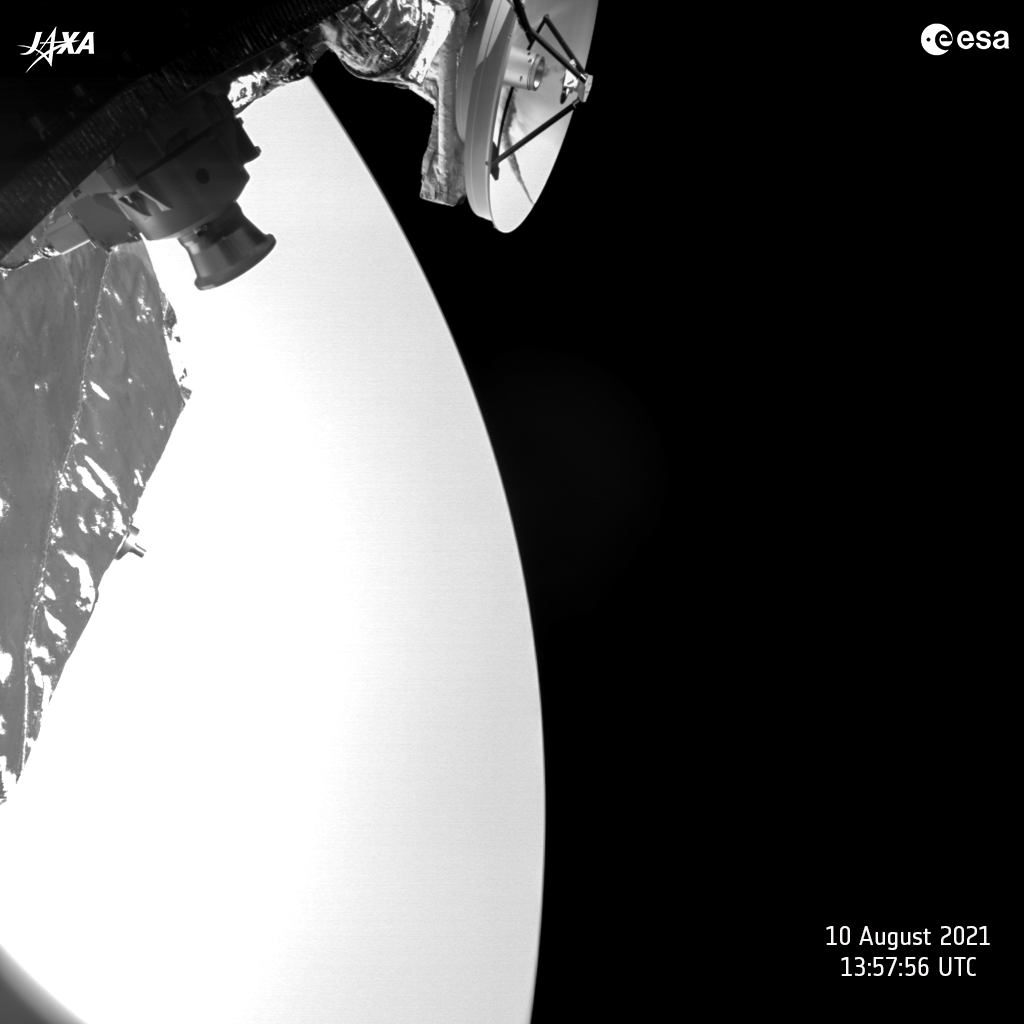VFB2 first data - BepiColombo Flyby
venus flyby #2 first images
This page contains data and images as they come from ESA, from single instrument teams, and also from ground based astronomers or space telescopes, observing and sensing Venus in the hours around the second flyby of BepiColombo.
1) Bepicolombo first image of venus: the monitoring cameras

from the ESA site: FEW MINUTES AFTER CLOSEST APPROACH
"The joint European-Japanese BepiColombo mission captured this view of Venus on 10 August 2021 as the spacecraft passed the planet for a gravity assist manoeuvre.
The image was taken at 13:57:56 UTC by the Mercury Transfer Module’s Monitoring Camera 3, when the spacecraft was 1573 km from Venus. Closest approach of 552 km took place shortly before, at 13:51:54 UTC.
The cameras provide black-and-white snapshots in 1024 x 1024 pixel resolution. The image has been lightly processed to enhance contrast and use the full dynamic range. A small amount of optical vignetting is seen in the bottom left of the image.
The high-gain antenna of the Mercury Planetary Orbiter and part of the body of the spacecraft are visible in front of Venus, at top left."
Credit: Images: ESA/BepiColombo/MTM
2) first video (& Sound): the accelerometer isa
from the ESA site: and on the ESA youtube channel:
"A sonification of data recorded by the Italian Spring Accelerometer (ISA) aboard the BepiColombo Mercury Planetary Orbiter spacecraft during the flyby of Venus on 10 August 2021 and the sequence of images of Venus are shown in this video.
The accelerometer data was converted to frequency to be made audible to the human ear. The resulting sound is rich with interesting effects due to the planet’s gravity acting on the spacecraft structure, the response of the spacecraft to the rapid temperature changes, and the change in reaction wheel velocity as they work hard to compensate for these effects. The audio has been matched to the timing that the images seen in this movie were captured, in the moments after closest approach."
Credit: Images: ESA/BepiColombo/MTM, CC BY-SA 3.0 IGO
Audio: ESA/BepiColombo/ISA/ASI-INAF, CC BY-SA 3.0 IGO
3) the solar wind at VENUS: the magnetometer MPO/MAG
from the ESA site: and on the ESA youtube channel:
"The variability of the total magnetic field during BepiColombo’s second Venus flyby is shown in this video as measured by the Mercury Planetary Orbiter’s Magnetometer (OB sensor).
The timeframe covers 12:00 to 14:30 UTC on 10 August 2021, including the closest approach at 13:51 UTC.
The data is not yet cleaned from high pitch spacecraft disturbances, but the lower-pitch wind-like sounds allow a rare glimpse into the solar wind interaction with a planetary atmosphere. For example, activity is detected on the approach to Venus and with the magnetic field 'pile-up' around closest approach. A more intense wind-like noise represents the turbulent magnetosheath region, before the sudden transition at the bow shock into the very calm solar wind."
Credit: ESA/BepiColombo/MPO-MAG/IGEP-IWF-IC-ISAS
- Removed a total of (1) style text-align:center;
- Removed a total of (1) style margin:0;
- Converted a total of (2) youtube to youtube-nocookie.








































 Sign in
Sign in
 Science & Technology
Science & Technology